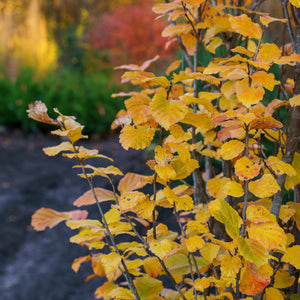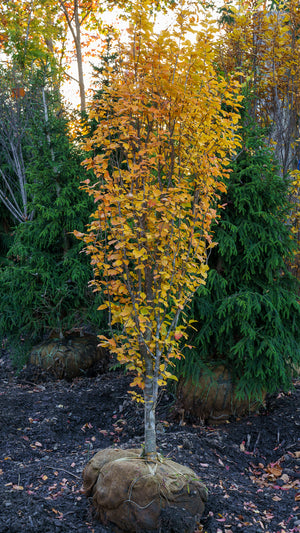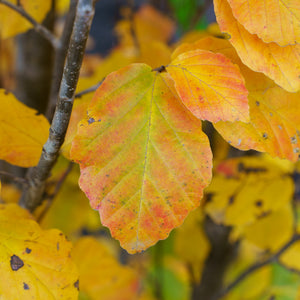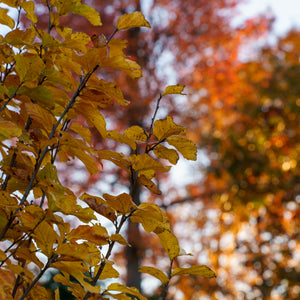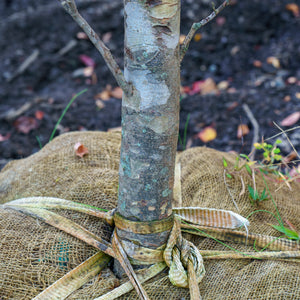Vanessa Persian Ironwood: A Show-Stopping Blend of Color and Elegance
Welcome to this week's edition of our Plant of the Week series. We are excited to feature the Vanessa Persian Ironwood (Parrotia persica 'Vanessa'), a tree that brings both vibrant seasonal beauty and a refined elegance to any landscape. Known for its stunning fall foliage and unique peeling bark, the Vanessa Persian Ironwood is a favorite among gardeners and landscape enthusiasts. With its upright, narrow growth habit, it’s an ideal choice for smaller gardens or urban spaces. Join us as we explore what makes this tree so unique and why it's a must-have for any outdoor setting.

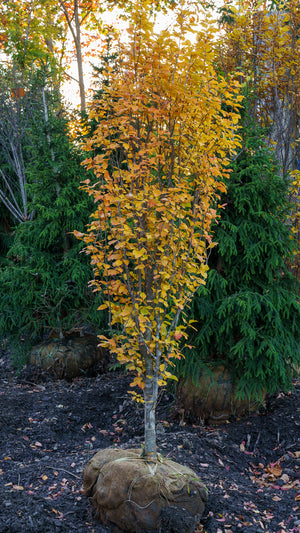
What Makes Vanessa Persian Ironwood Special?
The Vanessa Persian Ironwood is a standout tree, renowned for its year-round interest and distinctive features. This upright and narrow-growing variety of Persian Ironwood offers a more compact profile than the typical species, making it a great choice for smaller gardens or areas where space is limited.
One of the most captivating aspects of the Vanessa Persian Ironwood is its stunning fall display. In autumn, the leaves transform into a kaleidoscope of colors, ranging from bright yellows and oranges to deep reds and purples. This transformation creates a breathtaking spectacle, making the Vanessa a highlight in any garden. The glossy green leaves in the summer months provide a lush and vibrant backdrop, while in winter, the exfoliating bark reveals patches of cinnamon, gray, and cream, adding texture and visual interest when other trees are bare.
This cultivar is also known for its resilience and adaptability. Vanessa Persian Ironwood thrives in a variety of soil types, from loamy to slightly clay, and performs well in full sun to partial shade. It is drought-tolerant once established and is known to resist many common pests and diseases, making it a low-maintenance yet striking addition to any landscape.
In addition to its beauty and adaptability, the Vanessa Persian Ironwood provides excellent seasonal interest with its intricate branching pattern, small red flowers in late winter to early spring, and beautiful, serrated leaves. This makes it a tree for all seasons, bringing unique charm and elegance to gardens throughout the year.
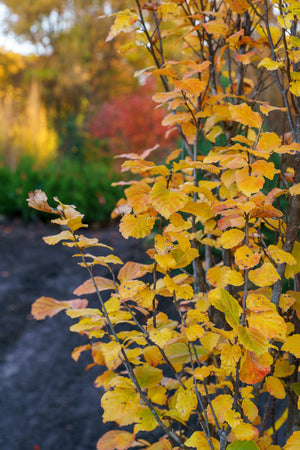
What is Vanessa Persian Ironwood Used For?
Ornamental Value: The Vanessa Persian Ironwood is primarily valued for its stunning foliage and unique bark. It provides a gorgeous focal point in gardens and is often used as a specimen tree. Its vibrant fall colors, glossy summer leaves, and winter bark texture make it a showstopper in any landscape.
Shade Provider: Despite its narrow form, the Vanessa Persian Ironwood’s dense canopy provides ample shade, making it suitable for shading patios, walkways, or seating areas. Its moderate height and columnar shape allow it to fit seamlessly into tighter spaces without overwhelming the landscape.
Urban Gardens: The Vanessa Persian Ironwood’s tolerance to pollution and compact growth habit makes it an excellent choice for urban gardens or small yards. Its upright form is ideal for lining streets, driveways, or fences, where space can be limited but beauty is still desired.
Wildlife Attraction: The Vanessa Persian Ironwood contributes to local biodiversity by supporting wildlife. Its flowers, although small, attract early pollinators in late winter or early spring, providing a valuable nectar source when few other plants are blooming.
Privacy and Screening: With its dense, upright form, the Vanessa Persian Ironwood can also serve as a natural screen or windbreak. It is a great choice for creating a privacy barrier or adding structure to garden beds without taking up too much horizontal space.

How to Care for Vanessa Persian Ironwood
Planting: Choose a well-drained location that receives full sun to partial shade. The Vanessa Persian Ironwood is adaptable to a range of soil types, including loamy and slightly clay soils. For best results, plant in the fall or early spring to give the tree time to establish its roots before extreme weather conditions.
Watering: Keep the soil consistently moist during the first few years to help the Vanessa Persian Ironwood establish a strong root system. Once established, this tree is relatively drought-tolerant, but deep watering during dry spells is recommended to maintain its health and ensure vibrant foliage.
Pruning: Minimal pruning is required, but you can shape the tree in late winter or early spring before new growth appears. Remove any dead or damaged branches to maintain the tree's health and form. Its natural shape is upright and narrow, making it easy to maintain without extensive pruning.
Fertilizing: Apply a balanced, slow-release fertilizer in the early spring before new growth begins. This will provide essential nutrients for healthy foliage and vibrant fall color. Avoid heavy fertilization, as the Vanessa Persian Ironwood is not a heavy feeder.
Mulching: Spread a 2-3 inch layer of organic mulch around the base of the tree, keeping it away from direct contact with the trunk to avoid moisture-related diseases. Mulching helps retain soil moisture, regulate temperature, and suppress weeds.
Protection: Generally hardy, the Vanessa Persian Ironwood does not require winter protection in most climates. However, young saplings may benefit from a light wrap of burlap during their first winter if you live in an area with harsh cold or high winds.
CONCLUSION
The Vanessa Persian Ironwood (Parrotia persica 'Vanessa') is a stunning choice for those looking to add year-round beauty and texture to their landscape. From its vivid autumn colors to its unique winter bark, this tree offers visual interest through all seasons. Its adaptability, low maintenance needs, and urban resilience make it a standout option for both city and suburban gardens. Whether you’re looking for a specimen tree, a privacy screen, or simply a splash of seasonal color, the Vanessa Persian Ironwood is a remarkable addition to any outdoor space, promising to captivate and delight for years to come.

